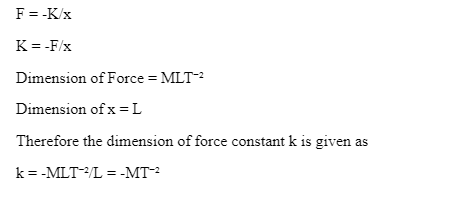Introduction:
Force constant is an alternative term for a spring constant, as defined by Hooke’s law. This law is a law of physics and is defined as the force required for the extension or compression of a spring by a distance x, varies directly (linearly) concerning that distance, that is, Fs = kx, where k is spring constant and is a characteristic of the spring and x is compression of the spring.
Restoring force
Let us understand the restoring force using an example. Imagine that spring is placed at a surface. In case of no external force, the spring remains in its resting position, i.e., the mean/central/equilibrium position. When someone pulls the spring outwards, i.e., when the external force is applied, then you will notice that an equivalent force is applied by the spring towards the central equilibrium position (in this case, inwards).
When someone pushes the spring inwards, then the force is applied by the spring towards the central position (in this case, outwards). Here, you must have noticed something. Whenever the spring is displaced from its mean position, a restoring force is exerted by the spring directed towards the equilibrium or mean position.
Let us now use F to denote force and x to denote the displacement of the spring from the equilibrium position. Thus we can represent the restoring force as:
F = -kx
In this equation, the negative sign (-) shows that the force is directed towards the opposite direction. The term ‘k’ in this equation is a constant term called the force constant. The unit of this term ‘k’ is Newton per meter.
Let the mass of the spring be m. In that case, the acceleration (a) will be:

The time period is the time required by the object to complete one oscillation. The frequency of simple harmonic motion is the total number of oscillations taken by the object per unit of time. Therefore we can represent the frequency as:

In the above equations:
a = acceleration
T= time period
F = force
f = frequency
m = mass
𝜔 = angular frequency
k = force constant
Force Constant
As per Hooke’s law, the force required in the compression or enlargement of spring is directionally related or proportional to the distance it is stretched. Force Constant is represented as K.
- F is the restoring force of the spring which is directed towards equilibrium.
- K is the spring/force constant in (N/m)
Alternatively, force constant is stated as the force exerted if the displacement is unity in the spring. If force F is considered, that stretches the spring so that it displaces from the equilibrium position by x.
Hooke’s equation (force constant equation) holds in many other situations where an elastic body is deformed, such as a wind blowing on a tall building, and a musician plucking a string of a guitar. An elastic body for which the force constant equation is true is said to be linear-elastic or Hookean.
Dimensional Formula of Spring Constant
Spring constant is defined as the restoring force per displacement. The Force is related linearly to the displacement of the system. It can also be defined as the force required for the expansion or compression of a spring is directly proportional to the displacement of the spring.
Mathematically,
We know that,

For linear springs
Consider a simple spring helical in nature which has a single end attached to a fixed object and the free end is being pulled by a force whose magnitude is Fs. Suppose that the spring has reached a state of equilibrium, where its length does not change. Let x be the figure by which the free end of the spring is removed from its relaxed position that is when it is not being stretched. Hooke’s law states that
F = Kx.
or, equivalently,

where k is a real number positive in nature, a characteristic of the spring. The same formula holds when the spring is in a compressed state, with F and x both are negative in that state. According to the force/spring constant formula, the graph of the applied force F as a function of the displacement x will be a straight line that passes through the origin, whose slope is k.
Conclusion :
- A higher spring constant implies a stiffer spring and vice versa is also true.
- The amount of spring stretch when plotted against the weight and then added to the hanger will give a straight line that runs through the origin. This means that the extension of a spring is directly related or proportional to the pulling force applied to it.
- In the world of springs, there are many exceptions to Hooke’s law. For example, an extension spring extended too far will not conform to the law. The length at which the spring stops the rule of Hooke’s law is called its elastic limit.
 Profile
Profile Settings
Settings Refer your friends
Refer your friends Sign out
Sign out




